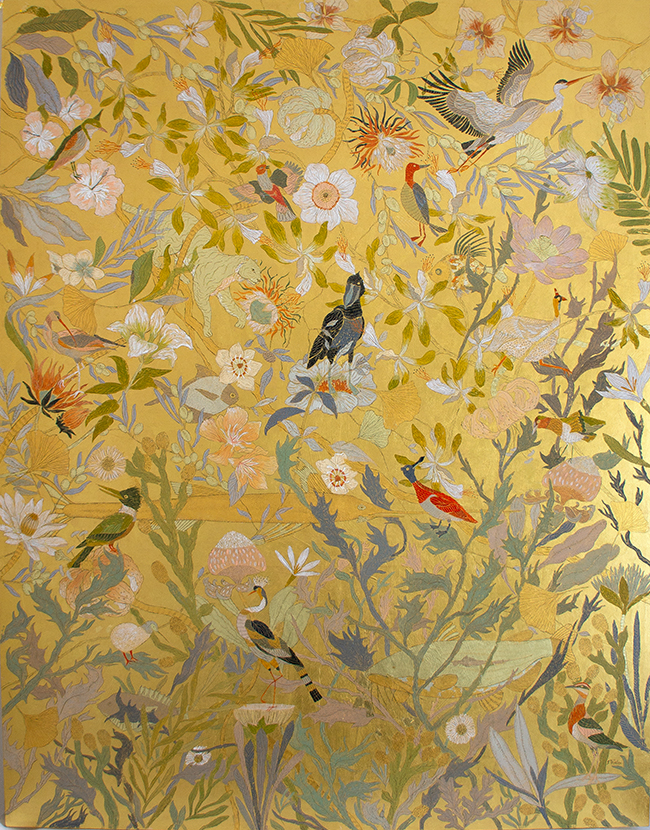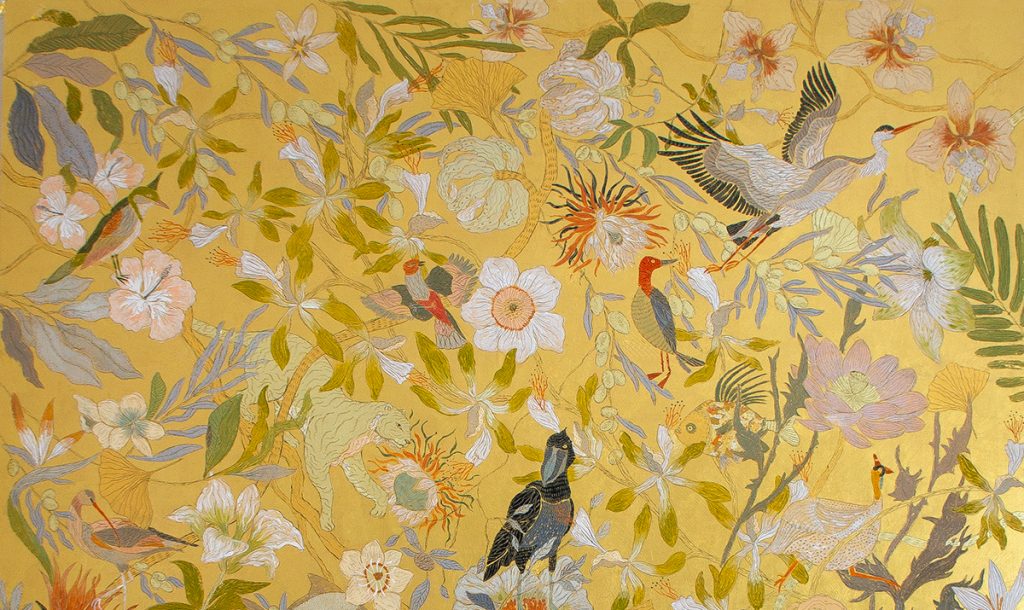Sigrid Thaler, an Italian artist currently based in Milan, has carved out a life in art that is as layered as the landscapes she paints. Born in Italy and raised in a small mountain city, her early surroundings left a lasting imprint—one of stillness, vastness, and natural beauty. Yet her path never stayed confined to one geography. She has lived and worked in Austria, Paris, Singapore, and São Paulo, carrying with her influences from Nordic clarity to German expression, from the cosmopolitan pulse of Paris to the tropical textures of Brazil. Each city left a trace, adding a different inflection to her visual language. Thaler’s work is less about fixed categories and more about flux—the meeting of cultures, the dialogue between nature and imagination, and the quiet persistence of memory. In her canvases, you find both rootedness and expansion, the balance between home and the wider world.

Meraviglia selvaggia
Title: Meraviglia selvaggia
Technique: Gold Leaf 22 karat and other different karats and acrylic on canvas
Size: 49 x 63 inches
Year: 2025
This painting, Meraviglia selvaggia (“Wild Wonder”), carries the weight of both commission and meditation. Thaler approached it not as a decorative task but as research—an inquiry into how elements of earth, air, and sea could be made to speak together on canvas. It is a work born of reflection, but also of freedom.
The first thing that meets the eye is light. Gold leaf, shimmering across the surface, does not sit passively; it catches and bends the gaze, forcing the viewer to shift perspective with every step. The use of 22 karat gold and other variations turns the painting into something both material and ethereal. It becomes a surface that reflects not only color but also time, recalling ancient icons while staying firmly contemporary.
Within this field of gold and acrylic, forms rise: fish, flowers, birds. At first they seem almost hidden, as if surfacing from the depths of memory or imagination. Then they settle into clarity, announcing themselves as fragments of the Indian Ocean and India’s lush biodiversity. But Thaler refuses cliché. These are not tourist images. They are lived impressions, transformed into painterly gestures—an ocean current rendered in a sweep of blue, a bird’s flight traced in a fine flick of line.
The composition breathes like a landscape, yet it is not a literal place. Earth, air, and sea weave together, their borders dissolving. This sense of merging is key. Thaler does not separate the natural world into compartments. Instead, she suggests continuity: the way fish glint like petals, the way a flower’s form recalls wings. Nothing is isolated. Everything belongs.
This unity has a rhythm. The painting seems to move, not in violent bursts but in a kind of steady dance. The eye follows arcs and spirals, like currents in water or breezes through trees. There is harmony, but not stasis. Each form leans into another, making the whole canvas pulse with quiet energy.
The scale of the work—nearly four feet by five feet—demands presence. Standing before it, you cannot take it in at once. The gold draws you close, the details invite attention, and then the sweep of the canvas pushes you back again. It is a rhythm of approach and retreat, echoing the cycles of the natural world.
The choice of gold leaf is also symbolic. It speaks of value, not in the sense of wealth but of reverence. By embedding natural motifs in gold, Thaler elevates them, reminding us that the everyday life of earth and ocean is precious. It is not an ornament—it is the ground of existence.
What gives Meraviglia selvaggia its strength is this blend of reverence and restraint. The painting never slips into excess. It carries richness without becoming ornamental, symbolism without didacticism. The viewer is left to feel wonder rather than be told what to think.
In the end, the painting is less a portrait of India’s nature and more a meditation on interconnectedness. Fish, flowers, and birds become emblems of how the world is woven together—each part vital, each part fragile. Thaler captures that sense not with heavy-handed realism but with gestures that let the imagination breathe.
Meraviglia selvaggia is a reminder that art can be both reflective and alive. It can hold memory, geography, and cultural reference while also standing as a living surface that changes with light and time. For Thaler, this is not simply a commission completed; it is another step in her ongoing conversation with place, nature, and the act of painting itself.

